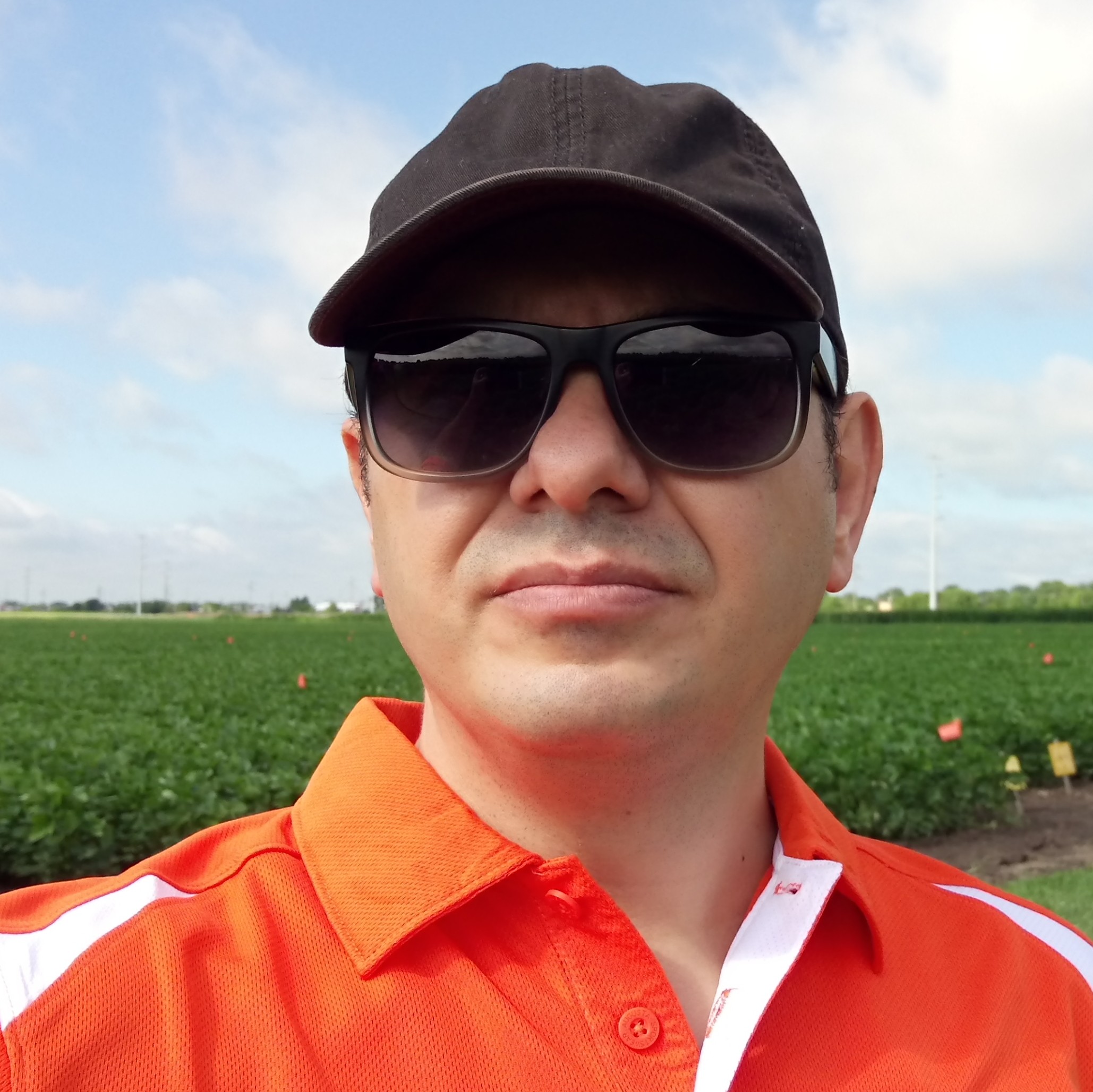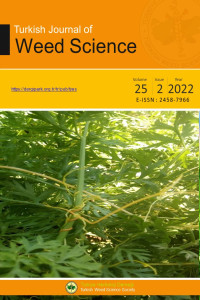Research Article
Aim & Scope
The Journal of Turkish Weed Science was started in 1998 by Turkish Weed Science Society. The journal was multilingual published twice a year. The journal publishes the original articles, consolidated reviews, short communications, survey articles with the conditions that the article or its parts are neither been published neither are under consideration by any other Journal currently. From 2015 to onwards, the journal will be continued in electronic OPEN ACCESS journal format with a new name (Turkish Journal of Weed Science). We extend our gratitude to everyone who contributed towards successful publication of the Journal to date.
We hope that all the authors will continue supporting the Journal and publish their esteemed research in Turkish Journal of Weed Science.
.Turkish Journal of Weed Science concentrates on primary research articles (Original Articles) but operates a flexible policy regarding other submissions, including Reviews, Short Communications, Survey Articles, and Research Reports. There are no page charges for Publication in Turkish Journal of Weed Science.
Our Editorial Team typically provides an editorial decision on new submissions within 3 to 6 weeks, and papers usually appear online within 10 weeks of initial submission. We are consistently working to provide authors with considerate, well-reasoned decisions in a prompt and efficient manner. Authors can log in to our editorial system to track the current status of their manuscript.
All of the manuscripts submitted to the journal are checked for plagiarism.
The main topics not exclusively focused by the journal are;
- Weed Taxonomy
- Weed Ecology and Physiology
- Weed Biology
- Weed Management and Control Methodologies
- Herbicide Behaviors and Resistance
- Weed Crop Interactions
- Invasive Plants
- Climate Change and Weed Management
- Allelopathy
- Plant Systematics
- Parasitic Plants
- Biodiversity
- Weed Risk Assessment
- Modeling and other fields of Weed Science.
Author Guidelines
.Manuscript format
Manuscripts should be written in Times New Roman 12-point font, with 1.5 line spacing except abstract. All page margins will be 2.0 cm. Section headings should be in bold face and 12-point font. The sub headings should be in bold and italic 10-point font. All pages and line should be numbered consecutively to facilitate ease of reference for the reviewers. Each paragraph should begin with an indentation of 0.5-cm. Tables and figures should be cited numerically and must beprovided at the end of the manuscript.
Language
Manuscripts should be written in concise, standard US English or Turkish, which must be carefully reviewed by the authors for correctness. Authors whose first language is not English are strongly advised to have their manuscripts checked by a native speaker prior to submission.
Supplementary Material
The journal also supports the supplementary data for manuscripts having large data sets; either figures or tables should be prepared as a separate document and submitted with the manuscript.
Research Articles
Research articles should not be longer than 25 pages (or 8,000 words), including tables and figures. Research articles should include an abstract and up to six keywords. The manuscript should include the following sections: Introduction; Material and Methods; Results; Discussion; Conclusion; Acknowledgments; References and Supplementary material, if any.
Short Communications
Short communications should be less than 12 pages (or 4,000 words), including tables and figures. Short communications should include an abstract with up to six keywords. Main text should be divided into sections as for research articles and can include a maximum of three tables/figures; and supplementary material, if any.
Review Articles
Each issue of the Journal includes a maximum of one review article, typically invited by the Editor and have no page limitation. The review article should include an abstract; up to six keywords a variable main text (the introduction should be based on general coverage of the issue, followed by a critical assessment of the most important references).
Layout
The following layout is strongly recommended. If the manuscript is not prepared according to the layout; it will not pass the technical check and immediately returned to authors
The first page must include the following:
i. Type of the article: i.e., Research, Short Communication or Review and Title of the work. The title must be clear, short and concise. The title should preferably not exceed 20 words.
ii. Author names: The first letter of authors first name should be written in Capital while the Family name must be in capitals. The authors name should be separated by comma (,). When authors are associated with different institutions, each author should be marked with a superscript. The corresponding author should be marked with an asterisk (*).
iii. The institution names of the each author to which they are affiliated should be given immidiately after the authors list. Each institution must start on a separate line
iv. Corresponding author´s e-mail address and telephone number should be prvidedimmidiatley after the institution names
v. The running title of the work, used in the heading of the pages of the printed article, should not exceed 80 characters (including spaces).
Abstract and keywords
Abstract
The articles of the Journal include an English or Turkish abstract. Turkish authors are responsible for writing abstracts in both languages while a Turkish abstract will be added by the Editorial office in the articles received from outside of Turkey. The abstract length is 200 words maximum for each of English and Turkish. The style must be concise and must not contain references. Abstract must describe the relevance of the study and establish the goal or the specific objectives; a brief description of the materials and methods; relevant results and one or two closing sentences addressing the most relevant findings and implications.
Keywords
A maximum of six key words (in English and Turkish separately) should be included. These should not repeat words that appear in the title.
Main Text
The following sections should be included in the main text
Introduction
The introduction should contain sufficient background information about the work to allow it to be placed in the context of other research and to allow the reader to understand the relevance, proposed objectives and evaluation of the results. The introduction should conclude with one or two sentences that define the objectives and the essence of the article.
Material and methods
Sufficient information should be provided to enable experiments to be repeated. For routine methods, a brief description and literature reference will be enough. New methods must be described in detail and, in the case of rarely used chemical products or equipment, the manufacturer’s name and address should be given.
Results
In general, this section should not include literature references; it should only describe the results of the experiments. Interpretations of the experimental data should be reserved for the Discussion section. The explanations provided in the figure and table captions should not be repeated in the text.
Discussion
The discussion should not be limited to describe experimental results and drawing conclusions; it should also be analytical and interpretative and should establish an association between the results obtained and other published works. The discussion may describe conflicting opinions and the results of other authors and indicate the value of these results for future works.
Conclusion
This section should conclude with a few sentences that summarise the most relevant conclusions and implications. Conclusions usually do not contain references but provide a short, general restatement of the main experimental results and their importance to the reader or the subject being discussed.
Acknowledgements
When it is considered necessary, acknowledgements should be made to the people, centres or bodies that have collaborated or supported the carrying out of the work. Authors are responsible for obtaining the necessary permission of the people or bodies mentioned, given that the readers might infer that they endorse the data and conclusions of the article.
References
When references are cited in the text, the author’s surname should be provided in parentheses, followed by a comma and the year of publication; for example, “(Chauhan, 2013) or Chauhan (2013)”. If there are two authors, the surnames should be followed by “and”; for example, “...(Chauhan and Abugho, 2007) or Chauhan and Abugho (2007)”. If there are three or more authors, include the surname of the first author followed by “et al.” and a comma; for example, “...(Golmohammadzadeh et al., 2015) or Golmohammadzadeh et al. (2015).”. The accepted papers which do not appear in an issue can be cited provided that they have a valid DOI. The references should be ordered from oldest to most recent; if they are from the same year, sort them alphabetically “(Chauhan and Abugho, 2007; Chauhan, 2013; Golmohammadzadeh et al., 2015).
References list
The references in the list must appear in alphabetic order by authors. Use full journal names. Examples are given below for literature references.
Journal Articles
Chauhan BS. (2013). Rice husk biochar influences seedling emergence of Junglerice (Echinochloa colona) and herbicide efficacy. American Journal of Plant Sciences, 4:1345-1350.
Chauhan BS., Abugho SB. (2013). Effect of water stress on the growth and development of Amaranthus spinosus, Leptochloa chinensis, and rice. American Journal of Plant Sciences, 4:989-998.
Golmohammadzadeh S., Zaefarian F., Rezvani M. (2015). Effects of some chemical factors, prechilling treatments and interactions on the seed dormancy‐breaking of two Papaver species. Weed Biology and Management, 15(1):11-19.
Books
Onen H. (2015). Invasive Plants Catalogue of Turkey. Abc publishing house, Ankara. ISBN: 1111-1111.
Book Chapters
Farooq S., Onen H., Ozcan S. (2015). Impacts of invasive alien Plants. In: Onen H. (eds). Invasive Plants Catalogue of Turkey. Abc publishing house, Ankara. ISBN: 1111-1111. pp. 34-57.
Mastes and Doctoral Theses
Akyol N. (2015). Expansion status of Common ragweed in Black Sea region of Turkey. Department of Plant Protection, Gaziosmanpasa University (M.Sc. Thesis). In Turkish with English abstract.
Internet References
Heap I. (2016). International survey of herbicide resistance weeds. Available: www.weedscience.org [Accessed: 01.02.2016].
Anonymous. (2016). Plant coordinate finder for SMARTER. Available: www.weedturk.com/en [Accessed:03.01.2016].
Accepted Articles - Articles in Press
Ozaslan C., Onen H., Farooq S., Gunal H., Akyol N. (2016). Common ragweed: An emerging threat for sunflower production and human health in Turkey. Weed Biology and Management. DOI: 10.1111/wbm.12093
Tables Figures
Tables and figures should be cited consecutively in the text, numbered independently and must be self- explanatory. Figures and tables must be of high quality and must be received in a suitable form and condition to be reproduced. Tables should be headed by a number and title. Explanatory notes that facilitate the interpretation of the tables should be included at the bottom of the tables. Figures may correspond to diagrams or photographs. The figure number and legend should be presented at the bottom of the figure. After the acceptance of the paper, photographs should be sent separately as image files (jpg, tiff or similar) with a finished size of at least 300 dpi (dots per inch). Tables and Figures should be provided at the en of manuscript after References section.
Abbreviations
1. Use abbreviations L, mL and µL for capacity or volume units. Express N (normality) as mmol/L and ppm as mg/kg or mg/L.
2. Abbreviations must be defined when first mentioned in the abstract or text [e.g., “polymerase chain reaction (PCR)”] and again in the tables and figures. Abbreviations must then be used throughout the article, except at the beginning of a sentence.
Scientific Names
Genus must be written in full the first time an organism is mentioned in the abstract or text and in every table and figure. If you are discussing several different species within a genus so that the genus is the same for each species mentioned, write genus + species in full the first time each new species is mentioned, even if it seems redundant. After the first time, use the genus abbreviation with a period. Genus and species are always italicised. Latin binomials or trinomials and authorities, when first mentioned, must be given for all plants, insects and pathogens (e.g., Ambrosia artemisiifolia L.). Both common and chemical names of pesticides/herbicides must be given when first mentioned (e.g., “Atrazine (2-chloro-4-ethylamino-6-isopropylamino-1,3,5-triazine) was most persistent...”).
Galley Proofs
Page proofs of articles are sent to authors as MS WORD files. Corrected proofs should be sent to the Editorial Office within three days by e-mail.
Ethical Principles and Publication Policy
Our Editorial Team typically provides an editorial decision on new submissions within 3 to 6 weeks, and papers usually appear online within 10 weeks of initial submission. We are consistently working to provide authors with considerate, well-reasoned decisions in a prompt and efficient manner. Authors can log in to our editorial system to track the current status of their manuscript.
All of the manuscripts submitted to the journal are checked for plagiarism.
The main topics not exclusively focused by the journal are;
- Weed Taxonomy
- Weed Ecology and Physiology
- Weed Biology
- Weed Management and Control Methodologies
- Herbicide Behaviors and Resistance
- Weed Crop Interactions
- Invasive Plants
- Climate Change and Weed Management
- Allelopathy
- Plant Systematics
- Parasitic Plants
- Biodiversity
- Weed Risk Assessment
- Modeling and other fields of Weed Science.
Price Policy
Our journal publishes free of charge
Indexes
Other Indexes
Journal Boards
EDITOR-in-CHIEF

Managing Editors


Editörler Kurulu





English Language Editors
Articles published in the journal are licensed under a Creative Commons Attribution-NonCommercial 4.0 International (CC BY-NC 4.0) license.






